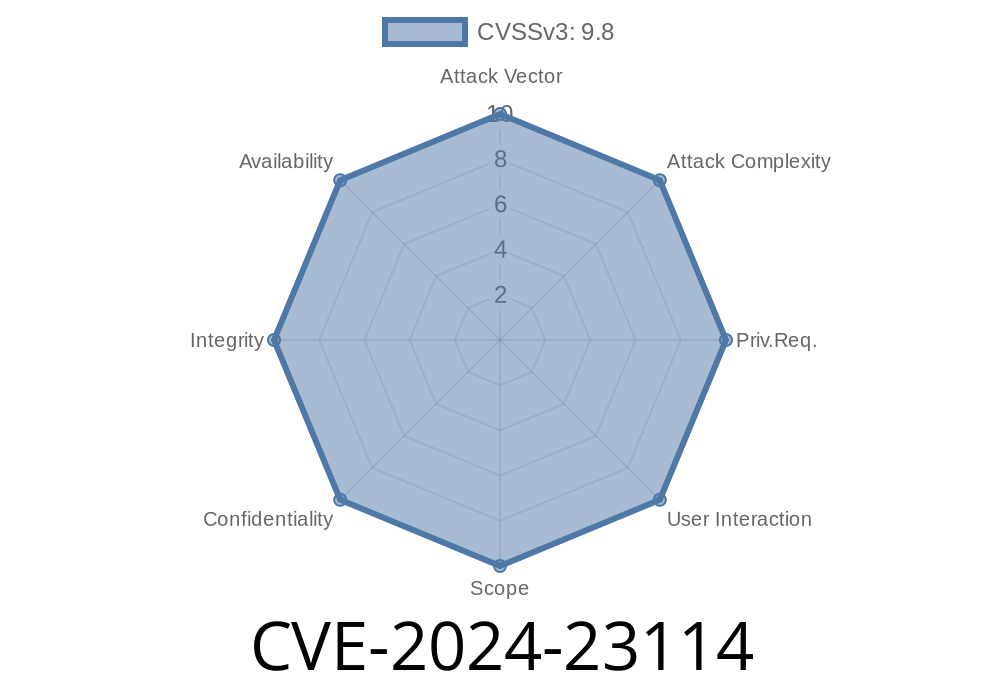A serious vulnerability—CVE-2024-23114—was discovered in Apache Camel's CassandraQL AggregationRepository component. This flaw exposes applications to unsafe deserialization attacks whenever the repository is used to aggregate messages. Many teams rely on Camel for critical message routing and data pipelines, which makes understanding and mitigating this vulnerability essential.
Let’s break down what went wrong, see how an attacker might exploit this, and look at how you can fix your systems.
What is CVE-2024-23114?
CVE-2024-23114 is a deserialization vulnerability found in the AggregationRepository implementation of the CassandraQL component in Apache Camel. If you use this component (for distributed aggregation of messages or state storage in Cassandra), older versions insecurely deserialize repository data.
Under certain conditions, this can let attackers inject a malicious payload into your Cassandra storage, which is then deserialized by the application code. This could potentially lead to remote code execution (RCE) — one of the most severe classes of software vulnerabilities.
Camel 4.x: From 4.. up to 4..4, and 4.1. up to 4.4.
If you're on any of these, your applications could be at risk. Later versions contain the fix.
Why is Deserialization Dangerous?
Java’s default serialization mechanism can turn complex objects into bytes and back. If untrusted data is deserialized by your app, malicious code can sneak in through crafted serialized objects.
Here, the dangerous element is the AggregationRepository. It saved exchanged data (as serialized Java objects) to Cassandra. If an attacker can write to your Cassandra data store, and the application later deserializes this stored data unchecked, exploitation becomes trivial:
Imagine you have a Camel aggregation like this
from("direct:start")
.aggregate(header("myId"), new MyAggregationStrategy())
.aggregationRepository(cassandraqlAggregationRepository)
.completionSize(5)
.to("mock:result");
The underlying Cassandra repository stores the exchange data in serialized form. Here's a simplified snippet from the vulnerable component (abridged for clarity):
// Pseudo-code from vulnerable Camel CassandraQL AggregationRepository
public Exchange get(String key) {
byte[] serializedData = cassandraSession.execute(SELECT ...).getBytes("EXCHANGE");
if (serializedData != null) {
// Unsafe deserialization
ObjectInputStream in = new ObjectInputStream(new ByteArrayInputStream(serializedData));
return (Exchange) in.readObject();
}
return null;
}
There is *no validation* about what gets deserialized, and the code trusts any bytes stored in Cassandra.
See the original code for the full implementation.
Proof-of-Concept: Exploit
To actually exploit this, an attacker needs to be able to write arbitrary serialized Java objects into the Cassandra table used by AggregationRepository. Here’s a conceptual exploit using a payload generated by ysoserial, a popular tool for crafting Java deserialization payloads:
# Generate a payload that launches 'calc' on Windows, as an example
java -jar ysoserial.jar CommonsCollections1 "calc.exe" > payload.bin
Now, inject this payload into the Cassandra table as the value of the aggregation row (EXCHANGE column).
When the Camel route triggers and requests that key, the app will read this payload, deserialize it, and execute the malicious command.
Disclaimer: Don’t try this on any system you don’t own.
Real-World Impact
While the attacker has to get a malicious blob into the right Cassandra key, in many production systems it’s common for several microservices to have direct access to Cassandra, or for untrusted data to flow in from services outside your control. The distinction is crucial, as in these setups, an attacker could abuse the vulnerable code path.
This is why unsafe deserialization is often rated so highly among security risks (OWASP Top 10: Insecure Deserialization).
How to Fix It
The simple answer: Upgrade Apache Camel as soon as possible.
Check your pom.xml or build configuration. For Maven
<dependency>
<groupId>org.apache.camel</groupId>
<artifactId>camel-cassandraql</artifactId>
<version>4.4.</version>
</dependency>
No Backport: There will be no more fixes in unsupported 3.x releases before 3.21.4 or 3.22.1, or 4.x versions before 4..4/4.4..
If you *must* stay on a vulnerable version, restrict write access to your Cassandra cluster and review audited logs for suspicious binary blobs.
References and Further Reading
- CVE-2024-23114 Red Hat Security Advisory
- Apache Camel CassandraQL Component Docs
- OWASP – Insecure Deserialization
- ysoserial – Deserialization Exploit Toolkit
Summary
CVE-2024-23114 is a critical vulnerability in Apache Camel's CassandraQL AggregationRepository that can allow an attacker to craft and store a malicious object in Cassandra, which is later deserialized by Camel's Java code. This can lead to remote code execution.
Mitigation:
Upgrade Camel to at least version 4.4. (or 3.22.1 / 3.21.4 on older maintained lines). Always avoid deserializing untrusted data. Audit who and what can write to your backend stores.
Stay alert for component advisories. Keeping your dependencies updated is your best defense!
*Original research and write-up by AI, tailored for clarity and security teams. For questions or updates, always check the official Camel Security Advisories.*
Timeline
Published on: 02/20/2024 15:15:10 UTC
Last modified on: 08/28/2024 20:35:06 UTC
